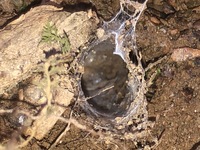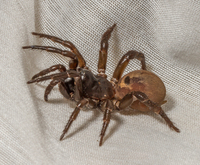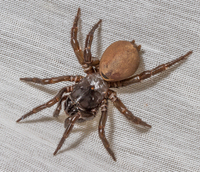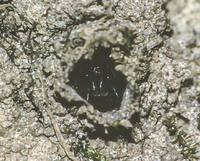Distribution Records
PDF
Vetting Levels |
|
Adult phenology:
High Mountains (HM) ≥ 4,000 ft.
Low Mountains (LM) < 4,000 ft.
Piedmont (Pd)
Coastal Plain (CP)
Click on graph to enlarge
|
 |
|
| synonym | |
| taxonomic_comments |
Greek antrodiaitos - "living in caves", from antron - "cave" + diaita - "way of life, dwelling" |
| species_comment |
Larger and males wander to mate earlier in fall than A. microunicolor |
| id_comments |
A dark chocolate brown coloration, the female has one dark abdominal tergite near the front. The female has robust chelicerae with a rastellum. The abdomen is lighter with a purplish cast. Toe fovea is longitudinal. The chelicerae of the male are narrower and have a tuft of stiff hairs at ht ends. The abdomen of the male has three tergites. Two pairs of spinnerets. |
| total_length |
Female carapace length more than 7mm, male carapace length more than less than 5.6 mm |
| structural_features |
|
| silk_web |
Burrow lined with silk, various lengths and angles, widened at the entrance and at the base. |
| fld_guide_descriptions |
|
| online_photos |
|
| prey |
Any arthropod within 7 centimeters of its burrow entrance, mostly ants and beetles. |
| predators |
Parasitized by Pompilid Wasps, centipedes, acrocerid flies, mites and theridiid spiders. |
| behavior |
These spiders build cryptic, silk-lined subterranean burrows that are concealed by a collapsible flexible turret or collar during daylight hours. After dusk, spiders prop open the collar and wait at the burrow entrance to seize passing insects and other prey items. |
| distribution_reference |
|
| technical_reference |
https://www.mapress.com/zootaxa/2005f/zt00872.; https://www.biodiversitylibrary.org/page/4753451#page/338/mode/1up.
Coyle, F.A. (1971) Systematics and natural history of the mygalomorph spider genus Antrodiaetus and related genera (Araneae: Antrodiaetidae). Bulletin of the Museum of Comparative Zoology, 141, 269–402. |
| adult_id | 1 identifiable by photo 2 identifiable by photo of specific features and/or supplementary info 3 identifiable from specimen only |
| abundance |
Occasional, males wander to breed in mid September through mid October. |
| distribution_comments |
Found throughout the Appalachians from northeastern Alabama and north to western Pennsylvania and Illinois. |
checklist_mt_high
>=4,000 ft. | |
checklist_mt_low
<4,000 ft. | |
checklist_pd
Piedmont | |
checklist_cp
Coastal Plain | |
| habitat |
humid, cool, densely forested habitats with sandy loam soil. Balds, forests with Hemlock and Rhododendron. Densest and largest burrow concentrations are usually found in inclined surfaces of slopes and banks along ravines, streams, roads, and trails, at the base of rock outcrops and other sheltered spots. |
| observation_methods |
Careful visual observation of burrows during day time, head lamps can locate them near burrow entrance at night. Pitfall traps. |
| state_protection |
|
| NHP_ranks |
|
| NHP_status |
|
| status_comments |
|
Photo Gallery for Antrodiaetus unicolor a foldingdoor spider |
 | Recorded by: Brian Bockhahn
Buncombe Co.
Comment: |  | Recorded by: Steve Hall
Cherokee Co.
Comment: Came to moth sheet but may have been disturbed from its burrow |
 | Recorded by: Steve Hall
Cherokee Co.
Comment: Came to moth sheet but may have been disturbed from its burrow |  | Recorded by: Steve Hall
Cherokee Co.
Comment: Came to moth sheet but may have been disturbed from its burrow |
 | Recorded by: Steve Hall
Orange Co.
Comment: |